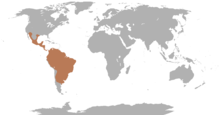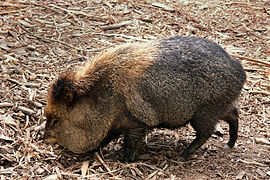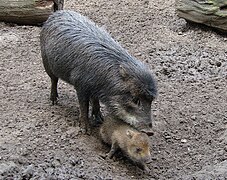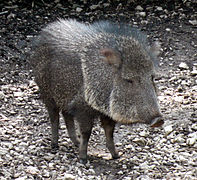Animal That Looks Like a Short Legged Pig Deer
| Peccaries Temporal range: Tardily Eocene – Holocene [1] | |
|---|---|
 | |
| Collared peccary, Dicolytes tajacu | |
| Scientific classification | |
| Kingdom: | Animalia |
| Phylum: | Chordata |
| Class: | Mammalia |
| Order: | Artiodactyla |
| Suborder: | Suina |
| Family: | Tayassuidae Palmer, 1897 |
| Type genus | |
| Tayassu Waldheim, 1814 | |
| Genera | |
 | |
| Range of the peccaries | |
| Synonyms | |
| Dicotylidae | |
A peccary (also javelina or skunk pig) is a medium-sized, pig-like hoofed mammal of the family Tayassuidae (New World pigs). They are establish throughout Primal and South America, Trinidad in the Caribbean, and in the southwestern area of North America. They usually mensurate between ninety and 130 cm (ii ft 11 in and four ft 3 in) in length, and a total-grown adult usually weighs about 20 to forty kg (44 to 88 lb).
Peccaries are social creatures that live in herds. They swallow roots, grubs, and a variety of foods. They can identify each other past their strong odors. A grouping of peccaries that travel and live together is called a "squadron". A squadron of peccaries averages between 6 and nine members. [2]
The last mutual ancestors of peccaries and other fifty-fifty-toed ungulates were vaguely piglike animals that lived over l 1000000 years ago. Peccaries evolved in Europe almost 30 meg years agone and spread across much of the earth. In the Old Globe, peccaries went extinct, simply they survived in Due north America. Virtually iii million years agone, peccaries spread into South America.
They are often confused [3] with feral domestic pigs of the Old Globe (family Suidae), normally known as "razorback" hogs in many parts of the United States, [4] when the ii occur in the wild in similar ranges.
Mayans kept herds of peccaries, using them in rituals and for nutrient. [5] They are kept equally pets in many countries, in addition to being raised on farms as a source of food. [vi]
Etymology [ edit ]
The word "peccary" is derived from the Carib give-and-take pakira or paquira . [7]
In Portuguese, a peccary is called pecari , porco-practise-mato , queixada , or tajaçu , among other names. In Spanish, it is called javelina , jabalí (a word too used to draw wild boar), sajino , or pecarí . The word "javelina" derives from the Castilian word for "wild boar". [8] In French Guiana and Suriname, the animal is chosen pakira.
The scientific name Tayassuidae derives the same source as the Portuguese tajaçu . [9]
Characteristics [ edit ]
A peccary is a medium-sized beast, with a stiff resemblance to a grunter. Like a grunter, it has a snout ending in a cartilaginous disc, and eyes that are small relative to its head. Besides like a grunter, it uses but the middle two digits for walking, although, dissimilar pigs, the other toes may be altogether absent. Its tum is not ruminating, although it has three chambers, and is more than complex than those of pigs. [ten]
Peccaries are omnivores and will swallow insects, grubs, and occasionally pocket-sized animals, although their preferred foods consist of roots, grasses, seeds, fruit, [10] and cacti—particularly prickly pear. [11] Pigs and peccaries can be differentiated by the shape of the canine tooth, or tusk. In European pigs, the tusk is long and curves around on itself, whereas in peccaries, the tusk is brusk and directly. The jaws and tusks of peccaries are adapted for crushing hard seeds and slicing into establish roots, [x] and they likewise utilise their tusks for defending against predators. The dental formula for peccaries is: ii.1.iii.3 3.one.3.iii
Past rubbing the tusks together, they can make a chattering noise that warns potential predators to stay away. In recent years in northwestern Bolivia almost Madidi National Park, large groups of peccaries have been reported to have seriously injured or killed people. [12]
Peccaries are social animals, oftentimes forming herds. Over 100 individuals have been recorded for a single herd of white-lipped peccaries, but collared and Chacoan peccaries normally course smaller groups. Such social behavior seems to have been the situation in extinct peccaries, as well. The recently discovered giant peccary (Pecari maximus) of Brazil appears to be less social, primarily living in pairs. [13] Peccaries rely on their social structure to defend territory, protect against predators, regulate temperature, and interact socially. [xiv]
Peccaries have scent glands below each eye and another on their backs, though these are believed to exist rudimentary in P. maximus. They use the scent to mark herd territories, which range from 30 to 280 hectares (75 to 700 acres). They also marker other herd members with these smell glands by rubbing 1 against another. The pungent scent allows peccaries to recognize other members of their herd, despite their myopic vision. The smell is potent plenty to be detected by humans, which earns the peccary the nickname of "skunk pig".
Species [ edit ]
Extant species [ edit ]
Three (perchance four) living species of peccaries are constitute from the Southwestern United States through Central America and into Due south America and Trinidad, each in their own genera.
- Tayassu
- White-lipped peccary (T. pecari)
- Catagonus
- Chacoan peccary (C. wagneri)
- Dicotyles
- Collared peccary (D. tajacu)
The collared peccary (Dicotyles tajacu) or "musk hog", referring to the animal'southward scent glands, occurs from the Southwestern United States into South America and the island of Trinidad. The coat consists of wiry peppered black, gray, and brown hair with a lighter colored "collar" circling the shoulders. They behave young year-round, but most frequently between November and March, with the boilerplate litter size consisting of two to 3 offspring. They are constitute in many habitats, from barren scrublands to humid tropical rain forests. The collared peccary is well-adapted to habitat disturbed by humans, merely requiring sufficient cover. They tin can be found in cities and agronomical land throughout their range. Notable populations exist in the suburbs of Phoenix and Tucson, Arizona, where they feed on ornamental plants and other cultivated vegetation. [15] [16] There are also urban populations as far north as Sedona, Arizona where they take been known to make full a niche like to raccoons and other urban scavengers. [17] In Arizona they are frequently called by their Spanish name "javelinas". Collared peccaries are generally constitute in bands of 8 to 15 animals of diverse ages. They defend themselves if they feel threatened, merely otherwise tend to ignore humans.
A 2nd species, the white-lipped peccary (Tayassu pecari), is mainly found in rainforests of Central and South America, but as well known from a wide range of other habitats such every bit dry forests, grasslands, mangrove, cerrado, and dry xerophytic areas. [18] The ii main threats to their survival are deforestation and hunting.
The tertiary species, the Chacoan peccary (Catagonus wagneri), is the closest living relative to the extinct Platygonus pearcei. Information technology is found in the dry shrub habitat or Chaco of Paraguay, Bolivia, and Argentina. The Chacoan peccary has the distinction of having been first described based on fossils and was originally thought to be an extinct species. In 1975, the animate being was discovered in the Chaco region of Paraguay. The species was well known to the native people.
A fourth equally yet unconfirmed species, the behemothic peccary (Dicotyles maximus), was described from the Brazilian Amazon and n Bolivia [19] by Dutch biologist Marc van Roosmalen. Though relatively recently discovered, information technology has been known to the local Tupi people as caitetu munde, which ways "swell peccary which lives in pairs". [20] [21] Thought to exist the largest extant peccary, information technology can abound to 1.2 k (iii ft xi in) in length. Its pelage is completely dark grey, with no collars whatsoever. Unlike other peccaries, it lives in pairs, or with one or two offspring. Nonetheless, the scientific show for because it every bit a species divide from the collared peccary has later been questioned, [22] [23] leading the IUCN to treat it as a synonym. [24]
Extinct genera [ edit ]
In addition, Tayassuidae accept a well-attested fossil record, and numerous extinct genera are known:[ citation needed ]
- † Aptenohyus
- † Cynorca
- † Egatochoerus
- † Floridachoerus
- † Macrogenis
- † Mckennahyus
- † Mylohyus
- † Perchoerus
- † Platygonus
- † Prochoerus
- † Prosthennops
- † Simojovelhyus [25]
- † Skinnerhyus
- † Thinohyus
- † Woodburnehyus
Evolution [ edit ]
Peccaries offset appeared in the fossil records of the Late Eocene or Early Oligocene periods in Europe. Fossils take subsequently been found in all continents except Australia and Antarctica. Peccaries became extinct in the Old World onetime later the Miocene flow, possibly considering of competition from evolving pigs. Extinct genera include the Miocene-anile Macrogenis and Floridachoerus . [26] Simojovelhyus , known from a lower partial mandible with three molars from tardily Oligocene strata well-nigh the town of Simojovel in Chiapas, Mexico, was originally described every bit a helohyid. [25]
Although common in South America today, peccaries did non reach there until about three meg years ago during the Swell American Interchange, when the Isthmus of Panama formed, connecting Northward America and Southward America. At that fourth dimension, many North American animals—including peccaries, llamas and tapirs—entered South America, while some South American species, such equally the ground sloths and opossums, migrated north. [27] Several species of peccary beyond the genera Platygonus and Mylohyus remained in Due north America until their extinction following the colonization of the continent past humans via Beringia at the end of the Pleistocene. Today, 2 of the iii species are relegated to the Neotropical realm, but the collared peccary ranges into northern United mexican states and the southwestern U.s..
Domestication [ edit ]
Peccaries carry a superficial resemblance to pigs and are in the aforementioned suborder Suina as swine, and take been present in South America since prehistoric times. [28] The earliest scientific clarification of peccaries in the New World is in Brazil in 1547 and referred to them every bit "wild pigs". [29]
Information technology has been documented that peccaries were tamed, penned, and raised for food and ritual purposes in the Yucatan, Panama, the southern Caribbean area, and Colombia at the time of the Conquest. [xxx] Archaeological remains of peccaries have been found in Mesoamerica from the Preclassic (or Determinative) period up until immediately earlier Castilian contact. [31] Specifically, peccary remains have been plant at Early Formative Olmec civilization sites. [32]
The peccary is not readily suitable for modern captive breeding, lacking suitable characteristics for intensive or semi-intensive systems. Peccaries crave a higher age before they are able to give birth (parturition) and have a tendency towards infanticide. [33]
Relation with feral pigs [ edit ]
Recently established Brazilian boar populations are not to be confused with long-established populations of feral domestic pigs, which accept existed mainly in the Pantanal for more than 100 years, along with native peccaries. The demographic dynamics of the interaction betwixt feral squealer populations and those of the two native species of peccaries (collared peccary and white-lipped peccary) is obscure and is still beingness studied. The existence of feral pigs could somewhat ease jaguar predation on peccary populations, every bit jaguars testify a preference for hunting pigs when they are available. [34]
References [ edit ]
- ^ "PBDB". paleobiodb.org . Retrieved 19 July 2022.
- ^ Organ Piping Cactus National Monument, Arizona - informational web site at https://world wide web.nps.gov/opi/acquire/nature/javelina.htm
- ^ George Oxford Miller (October 1988). A Field Guide to Wildlife in Texas and the Southwest . Texas Monthly Press. ISBN 978-0-87719-126-ane . Retrieved 26 December 2011. "many people confuse them with domestic pigs gone wild"
- ^ Susan L. Woodward; Joyce A. Quinn (2011). Encyclopedia of Invasive Species: From Africanized Honey Bees to Zebra Mussels . ABC-CLIO. p. 277. ISBN 978-0-313-38220-8 .
- ^ Dillon, Brian B. (1988). "Meatless Maya? Ethnoarchaeological Implications for Aboriginal Subsistence". Periodical of New World Archeology. vii: 60.
- ^ "Commercial farming of collared peccary: A Large-scale commercial farming of collared peccary (Tayassu tajacu) in North-Eastern Brazil". Pigtrop.cirad.fr (2007-04-30). Retrieved on 2012-12-18.
- ^ "Peccary". Online Etymology Dictionary . Retrieved 26 March 2012.
- ^ "javelina"
- ^ A. B. H. Ferreira, Novo Dicionário da Língua Portuguesa, second edition (Rio de Janeiro: Nova Fronteira, 1986), page 1530
- ^ a b c Castellanos, Hernan (1984). Macdonald, D. (ed.). The Encyclopedia of Mammals . New York: Facts on File. pp.504–505. ISBN 978-0-87196-871-five .
- ^ Sowls, Lyle Thousand. (1997). Javelinas and Other Peccaries: Their Biology, Management, and Use (2d ed.). Texas A&M University Press. pp. 69–lxx. ISBN 978-0-89096-717-one .
- ^ Madidi Diary – Joel Sartore Archived 17 January 2010 at the Wayback Machine. Sartorestock.com. Retrieved on 2012-12-eighteen.
- ^ Roosmalen, 1000.G.M.; Frenz, Fifty.; Hooft, W.F. van; Iongh, H.H. de; Leirs, H. (2007). "A New Species of Living Peccary (Mammalia: Tayassuidae) from the Brazilian Amazon". Bonner Zoologische Beiträge. 55 (2): 105–12.
- ^ Department, Arizona Game and Fish. "Living With Wildlife". www.azgfd.com . Retrieved 17 February 2016.
- ^ Friederici, Peter (August–September 1998). "Winners and Losers". National Wild fauna Magazine. 36 (5).
- ^ Sowls, Lyle K. (1997). Javelinas and Other Peccaries: Their Biology, Management, and Use (second ed.). Texas A&M University Printing. pp. 67–68. ISBN 978-0-89096-717-1 .
- ^ "Unwelcome visitors: Javelinas and humans exercise not mix well". The Daily Courier. 25 January 2008. Retrieved two February 2022.
- ^ Keuroghlian, A.; Desbiez, A.; Reyna-Hurtado, R.; Altrichter, Yard.; Beck, H.; Taber, A. & Fragoso, J.M.V. (2013). "Tayassu pecari". IUCN Red Listing of Threatened Species . 2013: e.T41778A44051115. doi: x.2305/IUCN.UK.2013-1.RLTS.T41778A44051115.en .
- ^ Moravec, J., & Böhme, W. (2009). Second Find of the Recently Discovered Amazonian Giant Peccary, Pecari maximus (Mammalia: Tayassuidae) van Roosmalen et al., 2007: Commencement Record from Bolivia Archived 29 Nov 2014 at the Wayback Machine. Bonner zoologische Beiträge 56(1–2): 49–54.
- ^ Lloyd, Robin (2007-eleven-02). Big Pig-Similar Beast Discovered. livescience.com
- ^ Behemothic wild grunter plant in Brazil. The Guardian (2007-xi-05). Retrieved on 2012-12-18.
- ^ Gongora, J., Taber, A., Keuroghlian, A., Altrichter, M., Bodmer, R.E., Mayor, P., Moran, C., Damayanti, C.S., González Due south. (2007). Re-examining the evidence for a 'new' peccary species, 'Pecari maximus', from the Brazilian Amazon. Newsletter of the Pigs, Peccaries, and Hippos Specialist Group of the IUCN/SSC. seven(two): xix–26.
- ^ Gongora, J., Biondo, C., Cooper, J.D., Taber, A., Keuroghlian, A., Altrichter, M., Ferreira exercise Nascimento, F., Chong, A.Y., Miyaki, C.Y., Bodmer, R., Mayor, P. and González, S. (2011). Revisiting the species status of Pecari maximus van Roosmalen et al., 2007 (Mammalia) from the Brazilian Amazon. Bonn Zoological Bulletin sixty(1): 95–101.
- ^ Gongora, J.; Reyna-Hurtado, R.; Beck, H.; Taber, A.; Altrichter, M. & Keuroghlian, A. (2011). "Pecari tajacu". IUCN Scarlet List of Threatened Species . 2011: e.T41777A10562361. doi: x.2305/IUCN.UK.2011-2.RLTS.T41777A10562361.en .
- ^ a b Prothero, Donald R.; Beatty, Brian L.; Stucky, Richard M. (2013). "Simojovelhyus is a peccary, not a helohyid (Mammalia, Artiodactyla)". Journal of Paleontology. 87 (5): 930–933. doi:10.1666/12-084. S2CID129670001.
- ^ White, T. Due east. 1942. The Lower Miocene mammal beast of Florida. Message of the Museum of Comparative Zoology 92(one):ane–49.
- ^ McDonald, Greg (1999-03-27) Pearce's Peccary – Platygonus Pearcei . Hagerman Fossil Beds' Critter Corner.
- ^ Gongora, J.; Moran, C. (2005). "Nuclear and mitochondrial evolutionary analyses of Collared, White-lipped, and Chacoan peccaries (Tayassuidae)". Molecular Phylogenetics and Evolution. 34 (i): 181–189. doi:10.1016/j.ympev.2004.08.021. PMID15579391.
- ^ Donkin, R.A. (1985). "The Peccary -- With Observations on the Introduction of Pigs to the New World". Transactions of the American Philosophical Society. 75 (v): three. doi:ten.2307/1006340. JSTOR1006340.
- ^ Donkin, R.A. (1985). "The Peccary -- With Observations on the Introduction of Pigs to the New Earth". Transactions of the American Philosophical Society. 75 (5): thirty,35–39. doi:10.2307/1006340. JSTOR1006340.
- ^ Donkin, R.A. (1985). "The Peccary -- With Observations on the Introduction of Pigs to the New World". Transactions of the American Philosophical Society. 75 (5): 29. doi:10.2307/1006340. JSTOR1006340.
- ^ Venderwarker, Amber M. (2006). Farming, Hunting, and Angling in the Olmec World. Austin, Texas: University of Texas Press. pp. 125–127, 131. ISBN 9780292726246 .
- ^ "Wildlife Policy Briefingaccessdate=21 October 2022" (PDF). December 2004.
- ^ Furtado, Fred (13 February 2009). "Invasor ou vizinho? Invasor ou vizinho? Estudo traz nova visão sobre interação entre porco-monteiro e seus 'primos' practice Pantanal". Ciencia Hoje. Archived from the original on 6 September 2008.
External links [ edit ]
Animal That Looks Like a Short Legged Pig Deer
Source: https://en.wikipedia.org/wiki/Peccary




Komentar
Posting Komentar